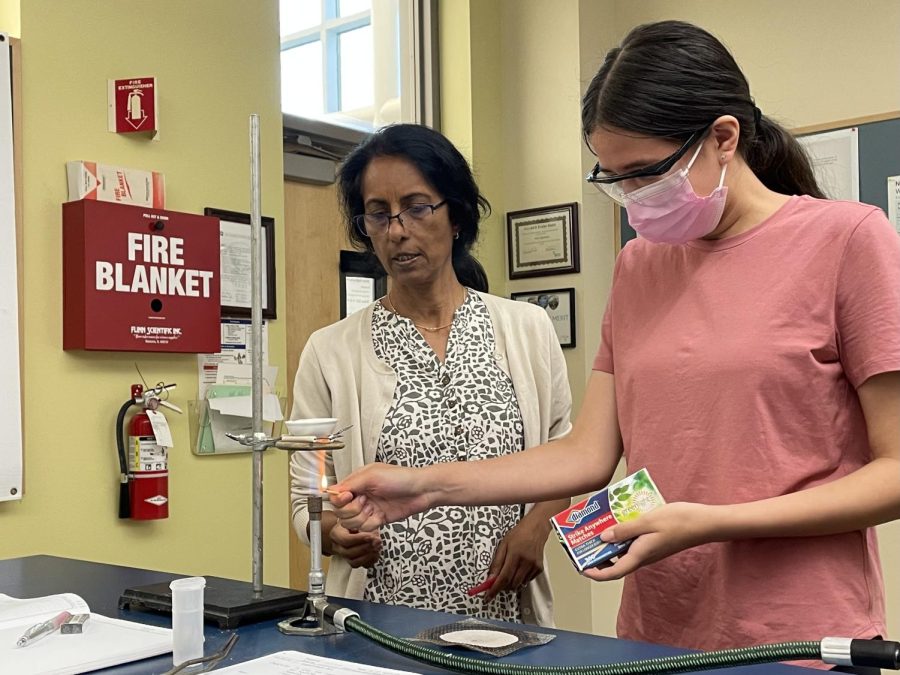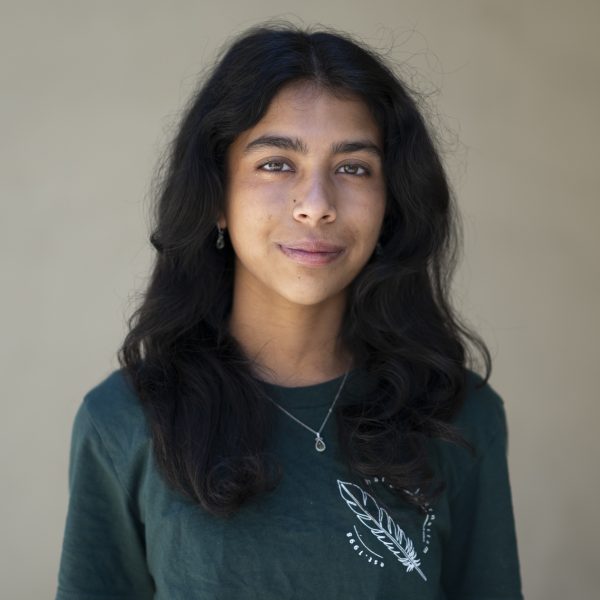Chemistry class completes first in-class experiment
Upper school chemistry teacher Dr. Mala Raghavan helps Jacqueline Soraire (11) light the Bunsen burner during the lab on Wednesday. Advanced Placement (AP) Chemistry class for juniors and seniors conducted their first experiment of the year on Wednesday.
September 20, 2022
Upper school chemistry teacher Dr. Mala Raghavan’s Advanced Placement (AP) Chemistry class for juniors and seniors conducted their first in-class experiment of the year on Wednesday during periods two and four.
The lab, titled “Mass % of sodium bicarbonate,” took place as the second lab of the year and served as the first experiment conducted by the students since the first lab was an at-home worksheet. This experiment also met dual purposes by allowing students to practice lab skills for the first time this year and by helping seniors adjust to the chemistry lab setting since they all took a required chemistry course during remote learning two years ago when conducting labs was not possible except towards the end of the year for a couple labs.
First, each pair of lab partners received a numbered vial containing a heterogeneous mixture, where the components are relatively separate, of sodium bicarbonate and sodium carbonate, the reactants of the experiment. The two compounds reacted to produce solid sodium carbonate as well as gaseous water and carbon dioxide.
With 19 vials total, each vial contained a different value for mass percent that Dr. Raghavan recorded on a private spreadsheet. After recording the masses of the vial’s sample and the crucible, a ceramic container used for heating, students placed the two over a Bunsen burner. The crucible’s material, however, left it easily susceptible to high temperatures, causing fracturing, which raised some concern for Ishani Sood (11) and her lab partner.
“It was kind of funny when we realized that our crucible was cracked after we had already started the experiment, so we were scared that our data would be off,” Ishani said. “Thankfully, it lasted and didn’t crack.”
Once the heating time finished, students allowed the crucible to cool for around five minutes before taking the mass of it. They repeated this process exactly, with the exception of heating for only three minutes, until the mass stopped changing. With all their data recorded, students finished calculating the mass percent of their respective bicarbonate answers at the end of the experiment. Each group then checked with Dr. Raghavan to determine the accuracy of their value.
“It was a fun activity,” Ishani said. “Although it wasn’t a complicated experiment, it was a good jump back into practicing lab skills and working in a lab.”


















![“[Building nerf blasters] became this outlet of creativity for me that hasn't been matched by anything else. The process [of] making a build complete to your desire is such a painstakingly difficult process, but I've had to learn from [the skills needed from] soldering to proper painting. There's so many different options for everything, if you think about it, it exists. The best part is [that] if it doesn't exist, you can build it yourself," Ishaan Parate said.](https://harkeraquila.com/wp-content/uploads/2022/08/DSC_8149-900x604.jpg)




![“When I came into high school, I was ready to be a follower. But DECA was a game changer for me. It helped me overcome my fear of public speaking, and it's played such a major role in who I've become today. To be able to successfully lead a chapter of 150 students, an officer team and be one of the upperclassmen I once really admired is something I'm [really] proud of,” Anvitha Tummala ('21) said.](https://harkeraquila.com/wp-content/uploads/2021/07/Screen-Shot-2021-07-25-at-9.50.05-AM-900x594.png)







![“I think getting up in the morning and having a sense of purpose [is exciting]. I think without a certain amount of drive, life is kind of obsolete and mundane, and I think having that every single day is what makes each day unique and kind of makes life exciting,” Neymika Jain (12) said.](https://harkeraquila.com/wp-content/uploads/2017/06/Screen-Shot-2017-06-03-at-4.54.16-PM.png)








![“My slogan is ‘slow feet, don’t eat, and I’m hungry.’ You need to run fast to get where you are–you aren't going to get those championships if you aren't fast,” Angel Cervantes (12) said. “I want to do well in school on my tests and in track and win championships for my team. I live by that, [and] I can do that anywhere: in the classroom or on the field.”](https://harkeraquila.com/wp-content/uploads/2018/06/DSC5146-900x601.jpg)
![“[Volleyball has] taught me how to fall correctly, and another thing it taught is that you don’t have to be the best at something to be good at it. If you just hit the ball in a smart way, then it still scores points and you’re good at it. You could be a background player and still make a much bigger impact on the team than you would think,” Anya Gert (’20) said.](https://harkeraquila.com/wp-content/uploads/2020/06/AnnaGert_JinTuan_HoHPhotoEdited-600x900.jpeg)

![“I'm not nearly there yet, but [my confidence has] definitely been getting better since I was pretty shy and timid coming into Harker my freshman year. I know that there's a lot of people that are really confident in what they do, and I really admire them. Everyone's so driven and that has really pushed me to kind of try to find my own place in high school and be more confident,” Alyssa Huang (’20) said.](https://harkeraquila.com/wp-content/uploads/2020/06/AlyssaHuang_EmilyChen_HoHPhoto-900x749.jpeg)







